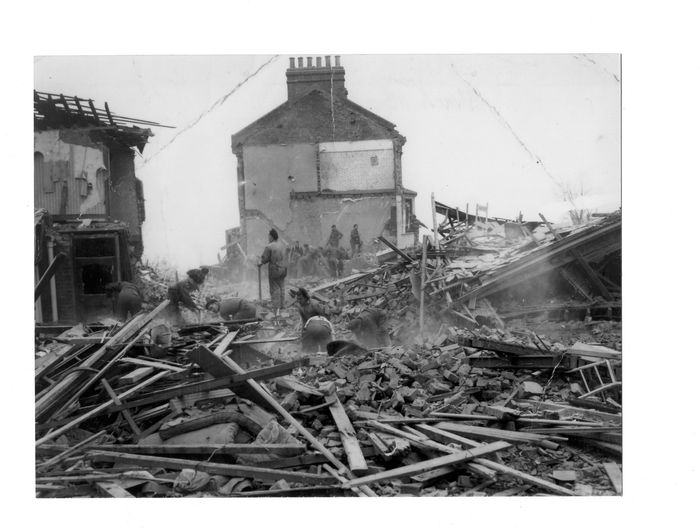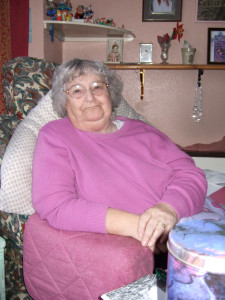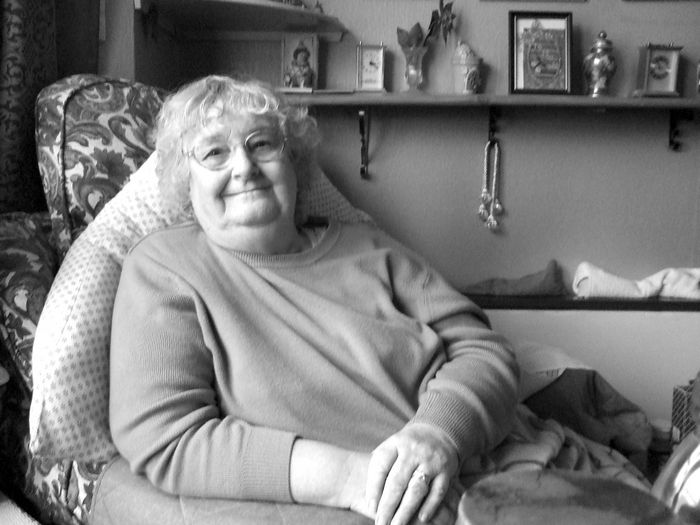March 1943 Clarence Road gets bombed
At first glance, the houses in Clarence Road by the corner of Aldborough Road seem Victorian, but a closer look at the brickwork reveals that they are relatively new.The original houses were destroyed by a German bomb in March 1943, and afterwards, in 1947, were skilfully rebuilt in the same style as the surviving houses in the terrace.
Doris Mitchell, (née Haffenden), pictured, who now lives in Newgate Road, was born at no. 2, Aldborough Road in 1931 (the house still standing in the centre of the photograph). Though no. 2 was the family home, none of the Haffendens were there at the time, being scattered in various places due to the war.
“It wasn’t a direct hit on the houses,” said Mrs Mitchell, “The bomb fell in one of the back gardens, so my father told me.” The bomb destroyed three houses in Clarence Road and one in Aldborough Rd.
Patrick Harbord, who lives in one of the rebuilt houses, said, “In one of the houses lived two sisters. One sheltered under the stairs when the bomb dropped and she died. The other sister survived. In the Aldborough Road house a lady was in the bedroom. She survived, but everything in the bedroom was destroyed except a picture on the wall. It was a picture of Jesus.”
The men in the photograph are Canadian soldiers who helped to clear the rubble and the bodies. Mrs Mitchell said, “They were very good. They were billeted at the Albany Hotel on the sea front – that was bombed too.” No. 1 Aldborough Road was divided into two flats, the upper flat belonging to the Nobles. Speaking of the picture of Christ, which amazingly survived untouched, despite all the destruction around it, Mrs Mitchell said, “It wasn’t even broken, not the glass, the frame; the nail wasn’t even bent. The Canadians asked if they could have it.”
Mrs Mitchell and her sister had been evacuated during the War. “I was 14 when the war ended,” she said, “and when we came home our house was still rickety, and people were building the next-door house up again. A man called Bill rebuilt the houses, and brought his young wife to live in one of them, but she died tragically in the bath from gas fumes because there was no flue.”
COMMENT
Michael Hoad writes (Apr 2008)
I have just had the opportunity to see a copy of the February edition of the ‘Voice’ and would like to add some more information regarding the article on Clarence Road which might be of interest. My father, Alfred Hoad of Tower Road West, was the builder involved with the rebuild of the properties. I have a photo of the houses which hung in the office over the years and dated 1948 which can be copied if necessary, taken looking North from the North Star.
The man ‘Bill’ referred to was indeed Bill Pelling, a bricky, and I, as a young lad being on site at the time, presumably with father when he was making his usual works inspection, added my name along with others, to a piece of paper which was put into a little bottle and laid in the foundation brickwork. My brother also recalls that due to the restrictions of war rebuilds, the mortar used was made up using slaked lime. This was made from burnt lime, on site in a puddled bund [what’s that? – ed]. This mixing of lime and water causes heat to build up and apparently a local cat either jumped or fell in and got its fur burnt severely.
Michael Hoad.
Leave a Response
You must be logged in to post a comment.




